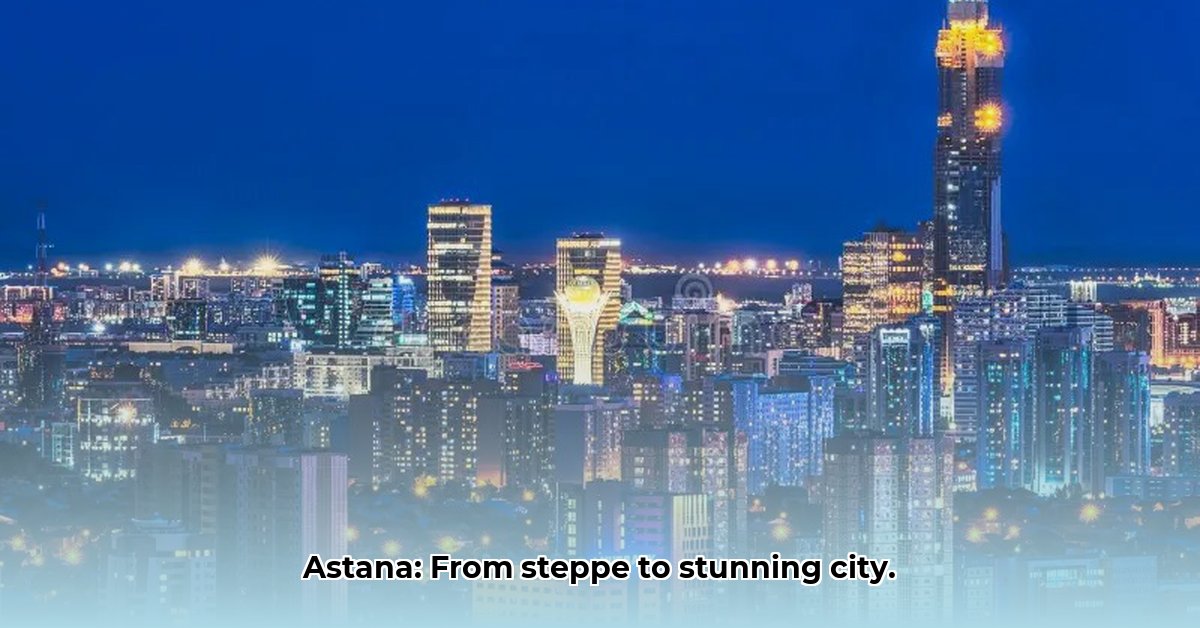
A City Built on Dreams – and Oil
Imagine the vast, flat expanse of the Kazakh steppe, stretching endlessly to the horizon. Now, picture a city bursting forth from this landscape – a modern marvel, a breathtaking testament to ambition fuelled by oil wealth and a powerful vision. This is Astana, Kazakhstan's capital – a city that transformed from a relatively small provincial town into a dazzling metropolis in a remarkably short time. Its transformation is a story both inspiring and thought-provoking. It wasn't a slow, organic growth; rather, a meticulously planned, rapid expansion that left the world in awe. Leading architects from around the globe were brought in, their designs shaping a skyline unlike any other – a futuristic blend of glass and steel against the backdrop of the ancient steppe.
A Political Masterstroke: More Than Just Buildings
The creation of Astana was far more than just erecting stunning buildings; it was a bold political statement. When President Nursultan Nazarbayev decided in 1997 to move the capital from Almaty, it sent a powerful message – a symbol of a newly independent Kazakhstan, forging its own path, creating a new national identity. The city's architecture reflects this: a striking fusion of traditional Kazakh designs and ultra-modern aesthetics. But this rapid growth prompts crucial questions: was this breakneck speed sustainable? Could such ambition ever truly balance aesthetics and functionality, beauty and practicality? Did the phenomenal growth adequately address the needs of the people?
The Price of Progress: Economic and Social Realities
Astana’s astonishing rise wasn't without its costs. The city’s construction boom relied heavily on oil revenues, creating dependence on a finite resource and making it vulnerable to global energy market fluctuations. This rapid expansion also raised concerns about social equity. Did the benefits of this dramatic change reach everyone equally? Were some communities displaced, their homes and lives disrupted in the rush to build a new capital? These questions demand honest and open discussion.
Research suggests that the initial economic benefits weren't evenly distributed, potentially leading to social inequalities. Professor Anya Petrova, an economist at the University of Oxford, states, "While Astana's GDP growth was undeniable, a more nuanced study is needed to assess the equitable distribution of this wealth. Data on income inequality, access to services, and housing affordability are crucial to a comprehensive understanding." Further research is necessary to fully understand the long-term social and economic impacts of this rapid urban development.
Environmental Concerns: The Ecological Footprint of Ambition
Astana's extraordinary speed of expansion inevitably brought environmental challenges. The construction, increased energy consumption, and traffic all contribute to a significant environmental footprint. How can a city achieve such ambitious growth while also protecting its environment? Balancing progress and ecological sustainability is a challenge Astana must actively address to ensure its long-term health and prosperity. Dr. Ben Marais, an environmental scientist at Stellenbosch University, adds: "The rapid urbanization of Astana presents a critical case study in sustainable development. Mitigation strategies focused on renewable energy, efficient resource management, and green infrastructure are paramount for long-term ecological wellbeing."
The Future of Astana: Navigating Challenges and Seizing Opportunities
Astana's future depends on various key players, each with a crucial role:
- Government: Sustainable urban planning, improved social welfare programs, economic diversification beyond oil, investment in resilient infrastructure, and promotion of public transport are vital priorities.
- Investors: Due diligence focusing on long-term sustainability, political stability, and potential for sustainable infrastructure projects is crucial to responsible investment.
- Residents: Active participation in community initiatives focused on improving living conditions and fostering a strong social fabric is critical in securing a better future for the city.
Astana's legacy is a work in progress. Its story is a compelling narrative of ambition, rapid transformation, and the complex realities of fast-paced development. While the architectural achievements are stunning, the city's long-term success depends on effectively addressing the social, economic, and environmental challenges resulting from such rapid growth. Its story continues to unfold, and the next chapter will be shaped by how these challenges are met.
How to Assess Social Equity Impacts of Astana's Rapid Urban Development
Astana's transformation from a relatively small city to a modern metropolis is remarkable. Billions have been invested in infrastructure. But behind this breathtaking architectural spectacle lies a complex story – one of breakneck growth and the crucial question: how to assess social equity impacts?
While economic indicators show growth, the true measure of success in Astana is understanding its impact on people. This requires a multifaceted approach. We cannot simply look at GDP; we need to delve deeper. Key aspects to consider include:
- Access to Services: Has improved infrastructure translated into equal access to essential services for all residents?
- Housing and Displacement: Were those displaced adequately compensated and housed? Did development benefit the wealthy disproportionately?
- Job Creation and Income Inequality: Were job opportunities distributed equitably? Did wealth favor specific segments of the population?
- Environmental Justice: Did certain communities experience disproportionate harm from the development process?
- Community Participation: Did local residents have sufficient input in planning and execution?
To adequately assess social equity, we need data. This involves meticulous surveys, interviews, and analysis of socioeconomic indicators across different communities. Without a solid data foundation, any conclusions would be speculative. The future of Astana hinges on addressing these equity issues, ensuring equitable growth moving forward. This means incorporating social impact assessments into future projects, guaranteeing that all members of society benefit from the city’s progress.